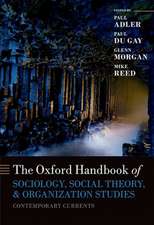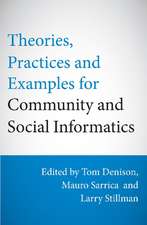Environments, Risks and Health: Social Perspectives: Geographies of Health Series
Autor John Eyles, Jamie Baxteren Limba Engleză Hardback – 16 aug 2016
| Toate formatele și edițiile | Preț | Express |
|---|---|---|
| Paperback (1) | 260.33 lei 6-8 săpt. | |
| Taylor & Francis – 30 sep 2020 | 260.33 lei 6-8 săpt. | |
| Hardback (1) | 1056.28 lei 6-8 săpt. | |
| Taylor & Francis – 16 aug 2016 | 1056.28 lei 6-8 săpt. |
Din seria Geographies of Health Series
-
 Preț: 385.84 lei
Preț: 385.84 lei - 24%
 Preț: 322.05 lei
Preț: 322.05 lei - 18%
 Preț: 1118.99 lei
Preț: 1118.99 lei -
 Preț: 489.26 lei
Preț: 489.26 lei -
 Preț: 394.37 lei
Preț: 394.37 lei -
 Preț: 436.18 lei
Preț: 436.18 lei - 18%
 Preț: 260.33 lei
Preț: 260.33 lei -
 Preț: 387.75 lei
Preț: 387.75 lei -
 Preț: 389.38 lei
Preț: 389.38 lei -
 Preț: 383.83 lei
Preț: 383.83 lei -
 Preț: 436.14 lei
Preț: 436.14 lei -
 Preț: 382.86 lei
Preț: 382.86 lei - 19%
 Preț: 259.98 lei
Preț: 259.98 lei - 19%
 Preț: 259.98 lei
Preț: 259.98 lei -
 Preț: 380.63 lei
Preț: 380.63 lei -
 Preț: 334.09 lei
Preț: 334.09 lei - 18%
 Preț: 1001.21 lei
Preț: 1001.21 lei -
 Preț: 389.66 lei
Preț: 389.66 lei - 18%
 Preț: 1001.55 lei
Preț: 1001.55 lei - 5%
 Preț: 1157.24 lei
Preț: 1157.24 lei
Preț: 1056.28 lei
Preț vechi: 1288.15 lei
-18% Nou
Puncte Express: 1584
Preț estimativ în valută:
202.11€ • 211.59$ • 167.24£
202.11€ • 211.59$ • 167.24£
Carte tipărită la comandă
Livrare economică 05-19 aprilie
Preluare comenzi: 021 569.72.76
Specificații
ISBN-13: 9781472410191
ISBN-10: 147241019X
Pagini: 256
Ilustrații: 80
Dimensiuni: 156 x 234 x 20 mm
Greutate: 0.5 kg
Ediția:1
Editura: Taylor & Francis
Colecția Routledge
Seria Geographies of Health Series
Locul publicării:Oxford, United Kingdom
ISBN-10: 147241019X
Pagini: 256
Ilustrații: 80
Dimensiuni: 156 x 234 x 20 mm
Greutate: 0.5 kg
Ediția:1
Editura: Taylor & Francis
Colecția Routledge
Seria Geographies of Health Series
Locul publicării:Oxford, United Kingdom
Cuprins
1. Quantitative Environmental Health
2. Uncertainty, Social Science and the Role of Theory
3. How certain is the cost or benefit? Can it be made safe?
4. Is it likely to happen?
5. Risk is Everywhere
6. Is the risk reversible?
7. Delayed Risk, Exposures and Health Outcomes
8. Who suffers most and what can be done?
9. Evaluating Environmental Risks to Health
10. And more of the same?
2. Uncertainty, Social Science and the Role of Theory
3. How certain is the cost or benefit? Can it be made safe?
4. Is it likely to happen?
5. Risk is Everywhere
6. Is the risk reversible?
7. Delayed Risk, Exposures and Health Outcomes
8. Who suffers most and what can be done?
9. Evaluating Environmental Risks to Health
10. And more of the same?
Notă biografică
John Eyles is a Distinguished University Professor at McMaster University, Canada. Based in Geography and Earth Sciences, he holds appointments in Clinical Epidemiology and Biostatistics, Sociology and the Centre for Health Economics and Policy analysis. His main research interests lie in environmental influences on human health and access to health care resources within a policy context. He has pursued that latter interest through a National Research Foundation South African Research Chair in Health Policy and Systems in the Centre for Health Policy, School of Public Health, University of Witwatersrand, where he is a Distinguished Research Professor.
Jamie Baxter is Professor in the Department of Geography at Western University, Canada. His research interests include: the social construction of risks from technological hazards, community responses to hazards, environment and health, noxious facility siting, and social science research methodology.
Jamie Baxter is Professor in the Department of Geography at Western University, Canada. His research interests include: the social construction of risks from technological hazards, community responses to hazards, environment and health, noxious facility siting, and social science research methodology.
Descriere
Offering the first comprehensive and cohesive summary of the input from social science to this field, this book focuses on how humans theorize their relationships to the environment with respect to health and how these ideas are mediated through an evaluation of risk and hazards. Bringing disparate literatures from across several disciplines together with their own applied research and experience, the book questions how social theories and models of the way the world works can contribute to understanding uncertainties. This book is essential reading for those working in the fields of health geography, environmental sociology, anthropology, environmental psychology and environmental politics.













